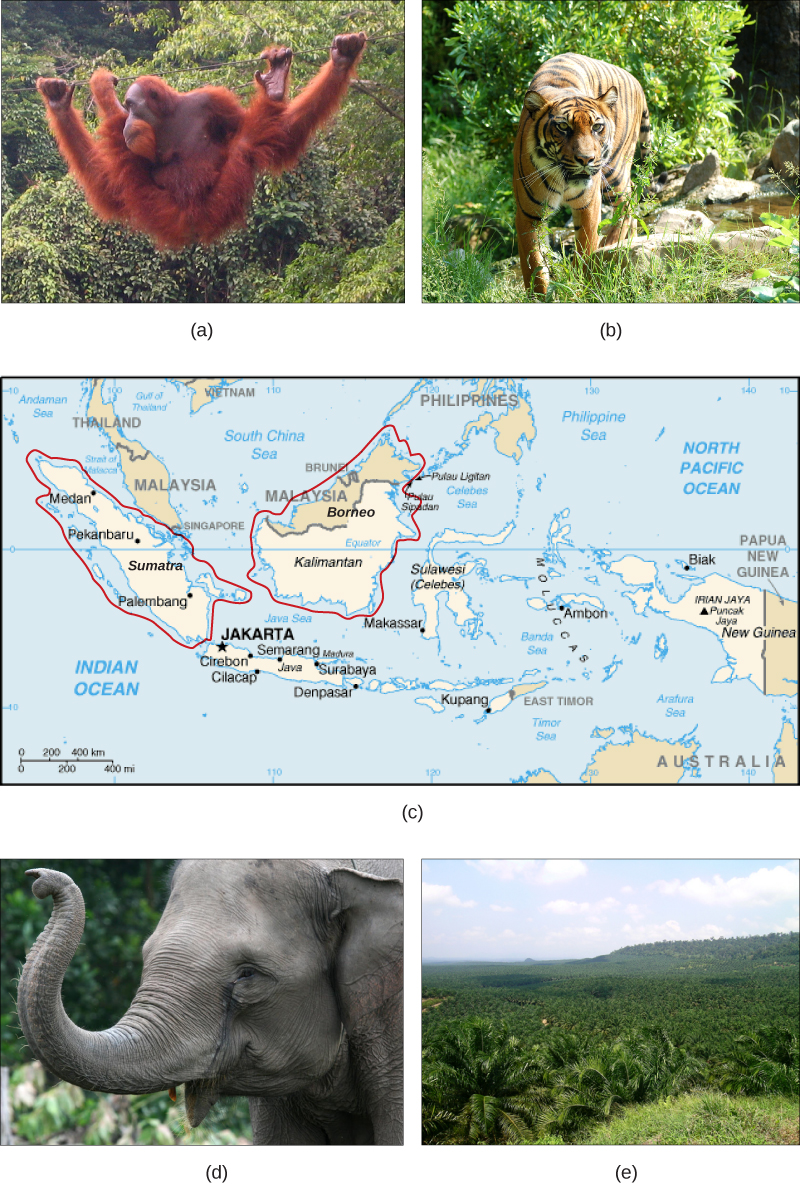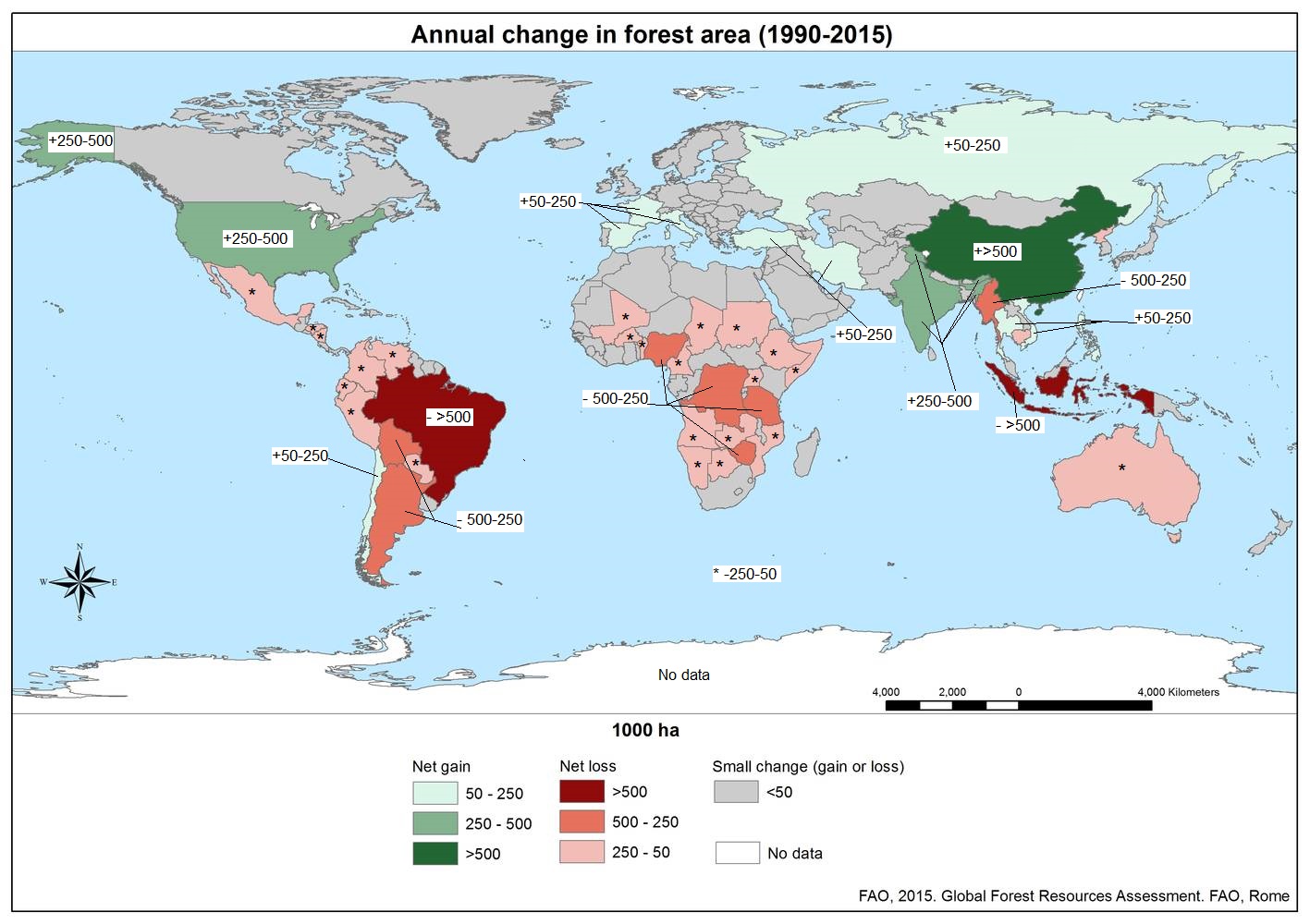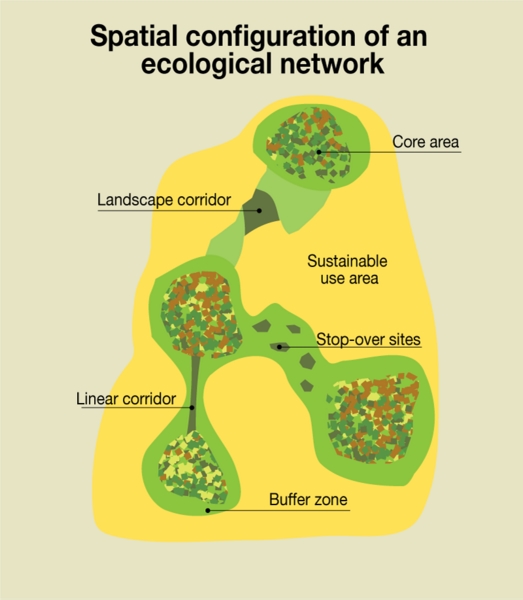13.1: Habitat Loss and Fragmentation
- Page ID
- 111137
Habitats
Natural habitats are the physical, chemical and biological systems that support living things (i.e. plants, animals, fungi and microbes). More simply put, habitats are the places where these organisms live. Habitat is lost and degraded when natural or human-caused activities alter these places so that fewer species can live there. For example, when a section of forest is cut down and replaced with farmland or urban spaces, the living places of hundreds of species may be eliminated.
Although natural events such as landslides and earthquakes do alter the landscape, they generally occur in isolated areas and healthy ecosystems are able to recover from them. Human-caused habitat loss, on the other hand, is altering ecosystems on a global scale, often causing destruction that is irreversible, at least on a time scale that is of interest to society.
Habitat loss is not only a concern from the point of view of compassion for other species that share this planet. Humans are part of the great cycle of life on earth, and as such we depend on the overall function of natural systems for our own survival. Properly functioning natural systems create the air we breathe, break down our wastes, provide our food, purify our drinking water and ultimately supply all the materials we require for living. Each species plays an important role in its ecosystem. Habitat loss and degradation is the main threat to the world's endangered plants and animals, and is occurring at ever greater rates.
Despite this sobering picture, habitat loss is not always an inevitable consequence of human activities. There are ways to limit our impact on natural systems, for example by using principles of "smart growth" in urban planning. Nevertheless, major changes and efforts are required to address this critical problem.
Habitat Loss
Habitat loss occurs when the physical environment required by a species is altered so that the species can no longer live there. Human destruction of habitats accelerated in the latter half of the twentieth century. Consider the exceptional biodiversity of Sumatra: it is home to one species of orangutan, a species of critically endangered elephant, and the Sumatran tiger, but half of Sumatra’s forest is now gone. The neighboring island of Borneo, home to the other species of orangutan, has lost a similar area of forest. Forest loss continues in protected areas of Borneo. The orangutan in Borneo is listed as endangered by the International Union for Conservation of Nature (IUCN), but it is simply the most visible of thousands of species that will not survive the disappearance of the forests of Borneo. The forests are removed for timber and to plant palm oil plantations (figure \(\PageIndex{a}\)). Palm oil is used in many products including food products, cosmetics, and biodiesel in Europe. According to Global Forest Watch, 9.7% of tree cover was lost globally from 2002 to 2019, and 9% of that occurred in Indonesia and Malaysia (where Sumatra and Borneo are located). Figure \(\PageIndex{b}\) shows the average annual change in forest area around the world from 1990 to 2015.


Preventing Habitat Destruction with Wise Wood Choices
Most consumers do not imagine that the home improvement products they buy might be contributing to habitat loss and species extinctions. Yet the market for illegally harvested tropical timber is huge, and the wood products often find themselves in building supply stores in the United States. One estimate is that up to 10% of the imported timber in the United States, which is the world’s largest consumer of wood products, is illegally logged. A 2012 United Nations and Interpol report estimated that the illegal timber trade is worth $30-100 billion each year. Most of the illegal products are imported from countries that act as intermediaries and are not the originators of the wood.
How is it possible to determine if a wood product, such as flooring, was harvested sustainably or even legally? The Forest Stewardship Council (FSC) certifies sustainably harvested forest products (figure \(\PageIndex{c}\)). Looking for their certification on flooring and other hardwood products is one way to ensure that the wood has not been taken illegally from a tropical forest. There are certifications other than the FSC, but these are run by timber companies, thus creating a conflict of interest. Another approach is to buy domestic wood species. While it would be great if there was a list of legal versus illegal woods, it is not that simple. Logging and forest management laws vary from country to country; what is illegal in one country may be legal in another. Where and how a product is harvested and whether the forest from which it comes is being sustainably maintained all factor into whether a wood product will be certified by the FSC. It is always a good idea to ask questions about where a wood product came from and how the supplier knows that it was harvested legally.

Estuaries and Wetlands
Habitat loss can affect ecosystems other than forests. Estuaries and wetlands are among the most productive ecosystems in the world, and provide many services of direct benefit to people; for example, water filtration and storage, and protection from storm surges and erosion. The habitats of these ecosystems are diverse. Intertidal mud flats, submerged eelgrass beds and salt marshes in estuaries house a diversity of animals including worms, crustaceans, shellfish, seabirds, shorebirds and waterfowl, fish (including commercially important species), seals, river otters, bears, raccoons and birds of prey. Wetlands host a similar diversity of freshwater species. Along with many microbe and plant species, these animals form a complex food web. Damage to or removal of one component of the food web can affect the function of the whole system.
For instance, about 85% percent of historical tidal wetlands in California, Oregon, and Washington have been lost. These estuaries serve as critical nurseries for juvenile salmon and steelhead as they make the transition from freshwater to the ocean. They are among the most dynamic and productive habitats known, also supporting migratory birds and a variety of other fish, shellfish, and terrestrial wildlife.
Unfortunately, in many cases the value of estuaries and wetlands has been overlooked by people who have viewed them only as "waste" areas that could be diked, drained and filled in for agriculture, urban development or other more "useful" purposes. Although our perception of the utility of these sensitive areas is slowly changing, the damage continues today. The results include increased erosion, storm surge and flood damage, degraded water quality, and decline or extinction of plants and animals. Habitats in estuaries and wetlands are also damaged by pollution and invasive species. When certain types of plants and animals are killed off from these effects, other species that depend on them also die off or, when possible, move to another area.
Habitat Fragmentation
Habitat fragmentation occurs when the living space of a species is divided into discontinuous patches. For example, a mountain highway could divide a forest habitat into separate patches. Imagine you are a red squirrel, living in a large, healthy woodland. Humans then come along and put a major road right through the middle of those woods. The road becomes a serious barrier, and trying to cross it could be the last thing you do. The patch of woodland on the other side of the road might just as well be fifty miles away. You can now only breed with those in your own limited patch. Your home is effectively an island, and the population is at risk of inbreeding. On top of this, if a disease, or some other natural catastrophe strikes, you and your kind could become locally extinct. The woods are now so cut off there’s little chance of squirrels making a comeback.
Habitat fragmentation is especially problematic for consumers at the top of the food chain, which require large ranges to find adequate prey. Since top predators often play a vital role in regulating populations of other organisms, the ecosystem can be seriously upset if they disappear.
Fragmentation can also lead to Edge effects, or changes in population or community structures that occur at the boundary of two or more habitats. For example, some species, including certain mosses and lichens, like damp, shady conditions. As a patch of forest shrinks, they may get exposed to too much sun or drying wind, and disappear. Areas with small habitat fragments exhibit especially pronounced edge effects that may extend throughout the range.
Solutions
Conservationists use a range of techniques to help increase connectivity in fragmented landscapes. These include creating corridors, buffers and stepping stones to help wildlife move around. Wildlife corridors mitigate the damage of habitat fragmentation by connecting patches with suitable habitat. A corridor can be anything from a hedgerow for dormice to a huge landscape-scale link. The basic idea is to create a direct connection between separate patches. For example, the bridge over a highway could allow animals to move between habitat patches (figure \(\PageIndex{d}\)). Riparian areas, areas of land adjacent to bodies of water, such as streams, can serve as natural wildlife corridors when left intact.

Some artificial links can help particular species. Badger tunnels and aerial runways for squirrels are used to help these animals negotiate roads. Stepping stones are patches of habitat which ease movement through the landscape. Buffer zones around a woodland can help to reduce the edge effect. They can also protect the interior of the woods from activities such as fertilizer spraying on adjacent land. When used together, corridors, buffer zones, and stepping stones can create an effective ecological network (Figure \(\PageIndex{e}\)).

Reconnecting habitats isn’t always straightforward, and we need to be careful not to create further problems. For example, by linking up two woodlands to help red squirrels we might accidentally help spread the invasive grey squirrel. Even so, these problems can be avoided with some careful planning. Re-establishing a more connected landscape should be seen as a conservation priority.
Watch researchers follow brown spider monkeys in a tropical forest of Colombia to determine which plant seeds they are dispersing. Seed dispersers are critical to the forest’s ability to grow and regenerate. As the tropical forests of Colombia are cleared for farmland and cattle ranches, the remaining patches of forest become fewer, smaller and further apart from each other threatening the survival of the animals that live there, including brown spider monkeys. Brown spider monkeys are critical seed dispersers and as their numbers decrease the forest is less able to regenerate. Andres Link and Carolina Urbina Malo of Los Andes University in Colombia are identifying the seeds that spider monkeys disperse to better understand the monkeys’ role in the forest and to predict which plants will be most affected by fragmentation. Once the seeds have been cataloged, Link and colleagues replant them to create corridors between isolated patches of forest.
References
Global Forest Watch. 2020. World Resources Institute. Accessed 2020-07-29.
Illegal logging nets organized crime up to 100 billion dollars a year, INTERPOL–UNEP report reveals. 2012. Interpol. Accessed 2020-07-29.
Attributions
Modified by Melissa Ha from the following sources:
- Threats to Biodiversity from Environmental Biology by Matthew R. Fisher (licensed under CC-BY)
- Threats to Biodiversity from General Biology by OpenStax (licensed under CC-BY)

